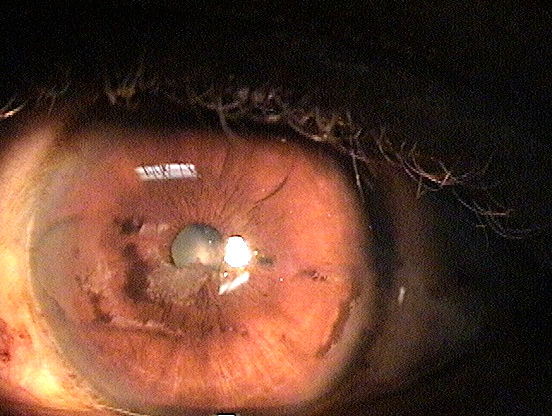

People with early keratoconus often notice a minor blurring or distortion of their vision, as well as an increased sensitivity to light, and visit their clinician seeking corrective lenses for reading or driving. ". a candle, when looked at, appears like a number of lights, confusedly running into one another" - Nottingham Simulation of the multiple images seen by a person with keratoconus. The word is from the Greek kéras meaning cornea and the Latin cōnus meaning cone. While it occurs in all populations it may be more frequent in certain ethnic groups such as those of Asian descent. It occurs most commonly in late childhood to early adulthood. However, some estimates suggest that the incidence may be as high as 1 in 400 individuals. Keratoconus affects about 1 in 2,000 people. In some cases, when the cornea becomes dangerously thin or when sufficient vision can no longer be achieved by contact lenses due to steepening of the cornea, scarring or lens intolerance, corneal cross-linking is not an option and a corneal transplant may be required. In 2016, the FDA approved corneal collagen cross-linking to halt the progression of keratoconus. In most people the disease stabilizes after a few years without severe vision problems. As the disease progresses, special contact lenses (such as scleral contact lenses) may be required. Initially the condition can typically be corrected with glasses or soft contact lenses. Keratoconus causes very distinctive changes in the appearance of these maps, which allows doctors to make the diagnosis. Topography measures the curvature of the cornea and creates a colored "map" of the cornea. The underlying mechanism involves changes of the cornea to a cone shape. Proposed environmental factors include rubbing the eyes and allergies. Patients with a parent, sibling, or child who has keratoconus have 15 to 67 times higher risk in developing corneal ectasia compared to patients with no affected relatives. While the cause is unknown, it is believed to occur due to a combination of genetic, environmental, and hormonal factors. In more severe cases a scarring or a circle may be seen within the cornea. This may result in blurry vision, double vision, nearsightedness, irregular astigmatism, and light sensitivity leading to poor quality-of-life. Keratoconus ( KC) is a disorder of the eye that results in progressive thinning of the cornea. A cornea from a donor (a recently deceased person) is inserted into the eye in the place of the patient’s own, damaged cornea.Blurry vision, nearsightedness, light sensitivity When visual acuity greatly deteriorates due to one of these causes, a corneal transplant may be performed.

The cornea may lose its transparency or become misshapen due to an infection, trauma, the improper use of contact lenses or due to an illness. With keratoconus, the cornea slowly but surely takes on the shape of a cone, and as this happens, the patient’s vision gradually worsens. Another disorder of the cornea is called keratoconus. The first is referred to as damage to the endothelial cells on the inside wall of the cornea. In some cases, the cornea can become clouded. Together with the lens, it is responsible for the refraction of the incoming light rays. The cornea is the transparent membrane at the very front of the eyeball.


 0 kommentar(er)
0 kommentar(er)
